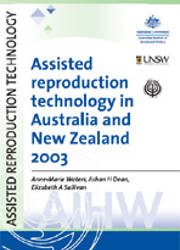Summary
Treatment characteristics
- During 2003, 39,720 treatment cycles were attempted in Australia and New Zealand. Of these, 90.7% (36,040) took place in Australia and 9.3% (3,680) in New Zealand.
- In Australia, there were 8.4 treatment cycles per 1,000 women of reproductive age (15–44 years). Correspondingly, in New Zealand, there were 4.2 cycles per 1,000 women of reproductive age (15–44 years).
- More than half (53.8%) of ART procedures involved fresh, non- donor oocytes or embryos, almost a third (31.9%) used frozen, non- donor embryos, 5.7% used oocytes or embryos received from a donor and 7.8% of cycles were intra-uterine insemination using donated sperm.
- The average age of women undergoing treatment in 2003 was 35.2 years. Their partners were aged on average 37.8 years.
- For fresh, non-donor (oocytes/embryos) cycles, 18.6% of all cycles started resulted in the delivery of at least one live baby. For frozen, non-donor (embryos) cycles, 13.9% of all cycles in which embryos were thawed resulted in the delivery of at least one live baby. The success of fresh, non-donor treatment varied among fertility centres. The highest ranked group of fertility centres achieved a live delivery in at least 20.2% of treatment attempts. The lowest ranked group of fertility centres achieved live delivery in less than 15.0% of treatment cycles.
- In 2003, the majority (95.6%) of treatment cycles transferred one or two embryos.
- The success of fresh, non-donor (oocytes/embryos) treatment cycles varied by women’s age. Women aged 25–29 years achieved the greatest success, with 27.7% of initiated cycles achieving a live delivery. Women aged 40–44 years had a success rate of 6.8%.
Pregnancies and births
- Overall, there were 8,365 pregnancies reported in the 2003 cohort. Of these pregnancies, 23.1% were less than 20 weeks gestation and 76.9% were at least 20 weeks gestation resulting in 7,479 liveborn babies and 108 fetal deaths.
- Of all pregnancies, 88.2% (7,374) were reported from fertility centres in Australia, resulting in 6,474 liveborn babies. Fertility centres in New Zealand reported 11.8% (991) of all pregnancies, resulting in 1,005 liveborn babies.
- Of the 8,365 pregnancies arising from the 2003 conception cohort, 20.7% resulted in miscarriage. Ectopic pregnancies accounted for 1.8%. A small proportion (0.6%) were either reduced or terminated.
- There were 1,163 (18.1%) multiple deliveries in the 2003 cohort. Of these, most (98.1%, 1,141) were deliveries of twins and a small proportion (0.3%, 22) were triplets.
- Half (50.0%, 3,203) of deliveries were by caesarean section, almost twice the proportion reported for all Australian births in 2003 (28.5%). Whereas 47.8% of ART mothers aged younger than 38 years delivered by caesarean section, only 27.5% of mothers in this age group in the Australian population did so. Similarly, 59.0% of ART mothers aged 38 years or older delivered by caesarean section, compared with only 41.1% of same-aged mothers in the Australian population.
- The average age of women giving birth was 34.4 years, 4.9 years older than the average age of Australian mothers in 2003 (29.5 years).
- The average gestational age of all babies was 37.2 weeks. More than a quarter (26.6%) of babies were born preterm with a gestational age of less than 37 weeks. This is a lower proportion than that reported in 2000 (32.6%), suggesting improved outcomes for babies following assisted reproduction.
- The average birthweight of all babies was 2,990 grams. Babies born with low birthweight (<2,500 g) made up 21.8% of all babies, which is less than the 26.4% of babies with low birthweight in 2000. However, babies born following ART in 2003 had a lower average birthweight than that reported for all babies in Australia in 2003 (3,372 g).
- There were 142 reported perinatal deaths in the 2003 cohort, comprising 108 fetal deaths and 34 neonatal deaths. This represents a perinatal mortality rate of 18.7 deaths per 1,000 births. This is higher than the perinatal mortality rate reported for the 2002 cohort (17.3 deaths per 1,000 births).



